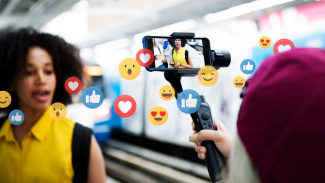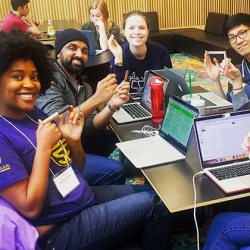Social Influencers Can Boost Attention Paid to Brands Yet Erode Sentiment Toward Video, Research Finds

The social media world is awash with people hawking products, services and, of course, themselves. But how much influence do the “influencer marketers” really have?
It’s a question for which there aren’t many solid answers. The detailed data is conspicuous in its absence for a sector that’s gone viral: The influencer marketing industry has reached a global valuation of around $10 billion, up from $2 billion a few years ago. There are at least 1,100 influencer marketing agencies, linking brands with influencers eager to promote them.
The gap in knowledge spurred research by Puneet Manchanda, marketing professor at University of Michigan’s Ross School of Business, and Prashant Rajaram, a doctoral candidate at Ross who graduates this year and will join the faculty at University of Western Ontario’s Ivey Business School. Their paper has been published as part of the Marketing Science Institute’s Working Paper series and is under review at a top marketing journal.
They used publicly available data on YouTube influencer videos to identify significant relationships between advertising content and views, interaction rates and sentiment. Among the key findings: Brand mentions in the first 30 seconds of a video are on average associated with a significant increase in attention to the brand but a significant decrease in sentiment expressed toward the video.
Manchanda and Rajaram jointly answer questions about the research and the influence it could have on the influencer marketing industry.
For all the ubiquity of influencer marketing and all the talk of TikTok, Twitch and older sibs like Twitter and YouTube, it’s surprising to learn that there is limited research on the design and effectiveness of the producers and industry. Why do you think that is given the stakes?
Influencer marketing is a fairly recent phenomenon, growing rapidly over the last four years. So it’s early days and the research world hasn’t caught up. It’s also important to note that as commonly happens with emerging marketing channels, it occupies a much larger share of mind then share of dollars. With about $10 billion being spent on it annually, influencer marketing accounts for a very small proportion of all digital marketing dollars and an even smaller proportion of all marketing dollars.
There is anecdotal evidence that some platforms, such as YouTube, have been doing some research on this, but they do not release their findings to the public. Marketers and agencies would like to see research, but they don’t have too much of an incentive to do so yet.
Another reason is that video is the preferred medium for this channel of marketing. Analyzing video content is complex and computationally demanding. The advent of powerful machine learning techniques is making this more feasible. Our research is one such example.
There’s an interesting note in your research: Brands find it very difficult to assess the return on investment of influencer marketing campaigns. That would of course speak to why more research like yours is needed. But also—and this gets beyond the scope of your research—why would brands be so willing to go as far as they have without reliable, rigorous data? How would you know you’re throwing good money after good?
As noted above, this new channel is occupying a lot of mindshare and so advertisers are driven by FOMO, or fear of missing out! But typical incentive structures within a company are about spending money on new channels as opposed to rigorously quantifying effectiveness. In other words, the emphasis is on the “throwing” part, rather than the “good “part.
Having said this, it is important to note that in today’s fragmented marketing environment, it isn’t easy to assess the return on advertising spend. We hope that our research points the way forward for more rigorous research.
This also gets beyond your research, but it’s remarkable just how pervasive this world, what some call the “attention economy,” has become. With influencers across every industry and with complicated, diverse motives and methods, how do marketing experts ever completely get their hands around it?
The notion that we are in an attention economy is very trendy right now. But again, it’s more hype than actually reflective of the economic activity. Every new communication and marketing medium leads to attention fragmentation as it emerges, and this is just the latest version.
For marketers, this is one more channel to deal with. Like social media, this channel brings the additional complexity that it’s not completely within the manager’s control, so it’s getting harder in terms of management. However, intermediaries such as influencer agencies have emerged, allowing marketers to outsource “influencer portfolio” management—for a fee, of course.
What’s the most surprising takeaway for you? What if anything seemed counterintuitive or confounding in the findings?
We think that the most surprising finding is that a brand mentioned in the first 30 seconds of an influencer video is associated with a decrease in positive sentiment. This is important, as sentiment is a good proxy for purchase intent. While this isn’t great news for the brand, this is also an issue for the influencer who has to thread the needle in terms of keeping the sponsoring brand happy, maintaining his or her independent “voice” and complying with the Federal Trade Commission’s regulations (requiring brand disclosure at the beginning of the video).
What else is important to highlight from the research?
Three things: First, we think that our research should act as a call to action for more research on the effectiveness of influencer marketing. Second, brands can use our approach as a template to evaluate videos that their influencers put out. Finally, influencer marketing relevance for brands can vary dramatically across product categories. For instance, we find that brand mentions hurt brands in the consumer electronics and video game categories more than others.







